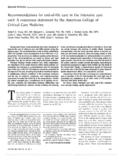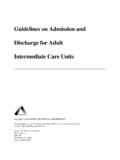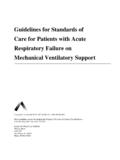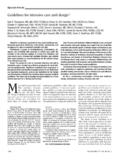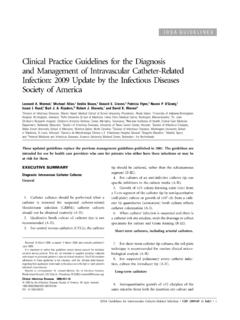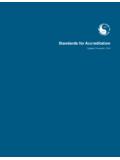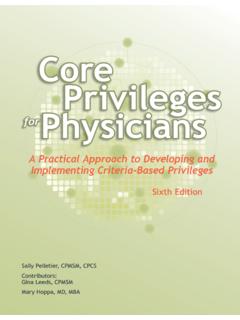Transcription of Management of the Potential Organ Donor in the …
1 Critical Care medicine 1291 Copyright 2015 by the Society of Critical Care medicine and Wolters Kluwer Health, Inc. All Rights : of the Potential Organ Donor in the ICU: Society of Critical Care medicine / american College of Chest Physicians/Association of Organ Procurement Organizations Consensus StatementRobert M. Kotloff, MD1; Sandralee Blosser, MD2; Gerard J. Fulda, MD3; Darren Malinoski, MD4; Vivek N. Ahya, MD5; Luis Angel, MD6; Matthew C. Byrnes, MD7; Michael A. DeVita, MD8; Thomas E. Grissom, MD9; Scott D. Halpern, MD5; Thomas A. Nakagawa, MD10; Peter G. Stock, MD11; Debra L. Sudan, MD12; Kenneth E. Wood, DO13; Sergio J. Anillo, MD14; Thomas P. Bleck, MD15; Elling E. Eidbo, MBA16; Richard A. Fowler, MBA16; Alexandra K. Glazier, JD, MPH17; Cynthia Gries, MD18; Richard Hasz, MFS, CPTC19; Dan Herr, MD20; Akhtar Khan, MD21; David Landsberg, MD22; Daniel J.
2 Lebovitz, MD23; Deborah Jo Levine, MD6; Mudit Mathur, MD24; Priyumvada Naik, MD25; Claus U. Niemann, MD11; David R. Nunley, MD26; Kevin J. O Connor, MS27; Shawn J. Pelletier, MD28; Omar Rahman, MD29; Dinesh Ranjan, MD30; Ali Salim, MD31; Robert G. Sawyer, MD28; Teresa Shafer, RN, MSN32; David Sonneti, MD33; Peter Spiro, MD34; Maryam Valapour, MD1; Deepak Vikraman-Sushama, MD12; Timothy P. M. Whelan, MD35; for the Society of Critical Care medicine / american College of Chest Physicians/Association of Organ Procurement Organizations Donor Management Task ForceAbstract: This document was developed through the collaborative efforts of the Society of Critical Care medicine , the american College of Chest Physicians, and the Association of Organ Procurement Orga-nizations. Under the auspices of these societies, a multidisciplinary, multi-institutional task force was convened, incorporating expertise in critical care medicine , Organ Donor Management , and transplantation.
3 Members of the task force were divided into 13 subcommittees, each focused on one of the following general or Organ -specific areas: death determination using neurologic criteria, donation after circulatory death determination, authorization process, general contraindications to donation, hemodynamic Management , endocrine dysfunction and hormone replacement therapy, pediatric Donor Management , cardiac donation, lung donation, liver donation, kidney donation, small bowel donation, and pancreas donation. Subcommittees were charged with generating a series of Management -related questions related to their topic. For each question, subcommittees provided a summary of relevant literature and specific recommendations. The specific rec-ommendations were approved by all members of the task force and then assembled into a complete document.
4 Because the available lit-erature was overwhelmingly comprised of observational studies and case series, representing low-quality evidence, a decision was made that the document would assume the form of a consensus statement rather than a formally graded guideline. The goal of this document is to provide critical care practitioners with essential information and practi-cal recommendations related to Management of the Potential Organ Donor , based on the available literature and expert consensus. (Crit Care Med 2015; 43:1291 1325)Key Words: critical care; Organ Donor ; Organ transplantationSpecial ArticleAs of December 2013, over 120,000 patients comprised the Organ Procurement and Transplantation Network (OPTN)/United Network for Organ Sharing (UNOS) waiting list (1). In 2012, only 22,187 Organ transplantations from 8,143 deceased donors were performed, and over 6,467 patients died while waiting for an available Organ (1).
5 This disparity between need and supply of transplantable organs is growing steadily in the United States, with the number of individuals on the waiting list far surpassing the number of available donors and organs. In addition to the obvious benefits to transplant recipi-ents, the psychological and social benefits of Organ donation for the Potential Donor and family are increasingly recognized (2). When the authorization process meets a Donation Service Area s Kotloff et al1292 June 2015 Volume 43 Number 6 The american College of Critical Care medicine (ACCM), which honors individuals for their achievements and contributions to multidisciplinary critical care medicine , is the consultative body of the Society of Critical Care medicine (SCCM) that possesses recognized expertise in the prac-tice of critical care.
6 The College has developed administrative guidelines and clinical practice parameters for the critical care practitioner. New guidelines and practice parameters are continually developed, and cur-rent ones are systematically reviewed and guidelines have been reviewed and endorsed by the american Association of Critical Care Nurses, the american Society of Transplanta-tion, and the United Network of Organ of Pulmonary medicine , Cleveland Clinic, Cleveland, Division of Pulmonary, Allergy, and Critical Care medicine , Penn State Hershey Medical Center, Hershey, PA, and Pittsburgh Critical Care Asso-ciates, Pittsburgh, of Surgery, Christiana Care Health System, Newark, Department of Surgery, Portland Veterans Affairs Medical Center, Port-land, , Allergy, and Critical Care Division, Hospital of the University of Pennsylvania, Philadelphia.
7 Of Pulmonary Diseases and Critical Care medicine , University of Texas Health Center at San Antonio, San Antonio, of Surgery, University of Minnesota Medical Center, Minne-apolis, Surgery Department, Harlem Hospital Center, New York, of Anesthesiology, University of Maryland Medical Center, Baltimore, Section of Pediatric Critical Care, Wake Forest Baptist Health Medical Center, Winston-Salem, Department of Surgery, University of California, San Francisco, San Francisco, of Surgery, Duke University Medical Center, Durham, Medical Center, Danville, Buffalo, Buffalo, of Neurology, Rush Medical College, Chicago, of Organ Procurement Organizations, Vienna, England Organ Bank, Waltham, Division of Pulmonary, Allergy, and Critical Care medicine , University of Pittsburgh Medical Center, Pittsburgh, of Life, Philadelphia, Department of medicine , University of Maryland Medical Center, Balti-more, of Surgery, Alleghany General Hospital, Pittsburgh, Department of Emergency medicine , SUNY Upstate Medical Center, Syracuse, Department of Pediatric Critical Care medicine , Akron Children s Hos-pital, Akron, Department of Critical Care medicine , Loma Linda University Children s Hospital, Loma Linda, , Atlanta, Division of Pulmonary and Critical Care medicine , University of Louisville Hospital, Louisville, Northwest, Bellevue, Department of Surgery, University of Virginia Health System, Charlot-tesville, Pulmonary and Critical Care, Indiana University Health System, India-napolis, Department of Surgery, Oscar G.
8 Johnson Veterans Administration Med-ical Center, Iron Mountain, Trauma, Burns, and Surgical Critical Care Division, Brigham and Wom-en s Hospital, Boston, Transplantation Society, Austin, Division of Pulmonary and Critical Care medicine , University of Wiscon-sin, Madison, Department, Harlem Hospital, New York, Division of Pulmonary, Critical Care, and Sleep medicine , Medical Uni-versity of South Carolina, Charleston, task force participants were required to submit conflict of interest statements. Supplemental digital content is available for this article. Direct URL citations appear in the printed text and are provided in the HTML and PDF versions of this article on the journal s website ( ).Supported, in part, by the Society of Critical Care medicine , american College of Chest Physicians, and Association of Organ Procurement Malinoski consulted for the Organ Donation and Transplanta-tion Alliance, lectured for multiple Organ procurement organiza-tions, and disclosed government work.
9 His institution received grant support from Health Resources and Services Administration (HRSA). Dr. Ahya consulted for Catapult Consulting (the entity is contracted by Cen-ters for Medicare and Medicaid Services to review lung transplant programs with lower than expected outcomes) and received royalties from UptoDate (Lung Transplant section in UptoDate). Dr. Byrnes is employed by the Saint Catherine Hospital. Dr. Nakagawa received royalties from UpToDate and con-sulted for the Department of Health and Human Services, HRSA, and the Organ Donation and Transplantation Alliance. Dr. Wood and his institu-tion received grant support from Agency for Healthcare Research and Quality grants. Mr. Eidbo has disclosed that he is executive director of the Association of Organ Procurement Organizations (AOPO).
10 Mr. Fowler received support for article writing/review from the AOPO (led AOPO s expert review of the article and associated revisions), consulted for the AOPO (independent con-sultant relevant client during the time period) and the Washington Regional Transplant Community (independent consultant relevant client during the time period), and has stock in Johnson & Johnson. Dr. Gries received sup-port for travel from american Society of Transplantation (travel to Board of Directors meeting, travel to give talk). Her institution received grant support from PneumRx. Dr. Mathur is employed by the Faculty Physicians and Sur-geons of Loma Linda University School of medicine . His institution received grant support from the National Heart, Lung and Blood Institute (the Thera-peutic Hypothermia after Pediatric Cardiac Arrest trials).
